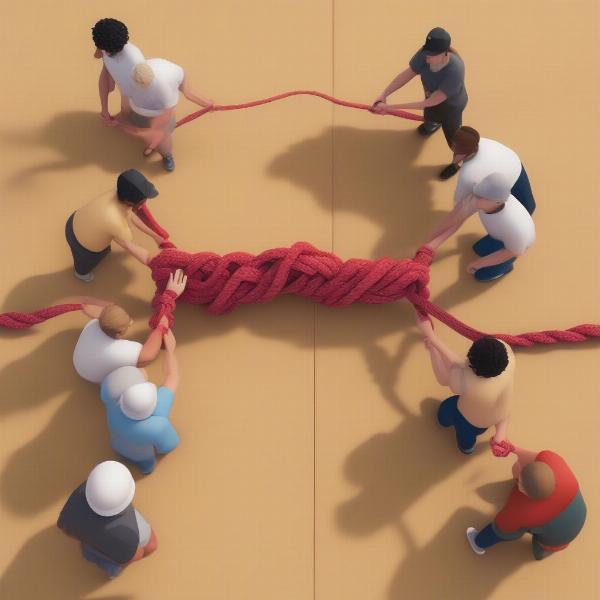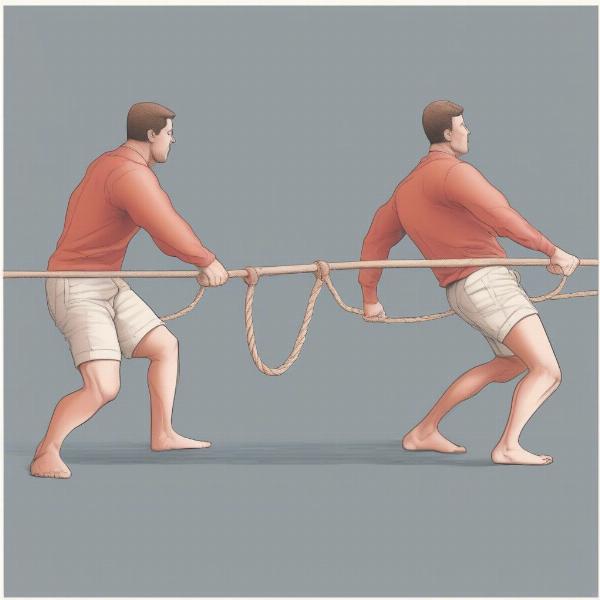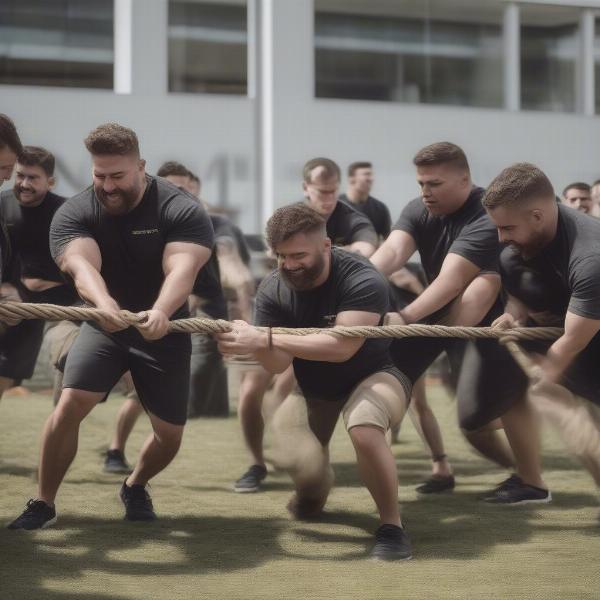The tug of war challenge in Squid Game is far more complex than a simple strength contest. It’s a brutal lesson in strategy, teamwork, and psychological warfare, and understanding these elements is key to success, even if your life isn’t on the line. Here at SupremeDuelist.blog, we’re dedicated to dissecting the mechanics, tactics, and meta of popular games and entertainment, providing valuable insights for our readers.
At Supreme Duelist Blog, our mission is to go deeper than surface-level analysis. We’re not just here to tell you what happened; we want to explain why it happened and how you can apply those lessons to your own games and life. This detailed breakdown of the Squid Game tug of war will give you a clear understanding of the crucial strategies that dictated who survived and who didn’t.
Understanding the Basics of Squid Game’s Tug of War
The core of the game is simple: two teams pull on a rope, trying to drag the other team across a center line. However, the Squid Game version adds a terrifying twist; the losing team plunges to their death. This high-stakes environment dramatically elevates the importance of strategy, and it’s more than just brawn. It’s about using your weight and leverage effectively, and, perhaps more importantly, working together as a unit.
- Initial Positioning: The positions of each team member on the rope matter immensely. Those at the front endure the initial brunt of the force, while those at the back can act as anchors.
- Synchronized Pulling: Random, individual pulling doesn’t work. Success relies on all team members pulling in unison, and at the same pace.
- Leverage and Stability: Proper footing and body positioning are needed to maximize pulling power and prevent being dragged forward.
- Psychological Warfare: Knowing how to demoralize your opponent while keeping up team morale is essential in this battle.
Why Team Composition Matters
The composition of your team matters just as much as their technique. Having strong individuals is good, but they need to complement each other and form a cohesive unit. The best teams combine muscle with individuals who understand leverage and strategy. Having a variety of body types can also work to your advantage, as lighter individuals might be more agile and better suited to pull from a strategic position along the rope.
 Squid Game tug of war team positions
Squid Game tug of war team positions
The Importance of Team Coordination
Synchronized effort is critical in tug of war. It’s not about who can pull the hardest, but who can pull together the hardest. It’s essential for your team to find a rhythm that uses all members at their maximum potential. A simple example of this is that if one member is pulling slightly before the others, their pull is ineffective, and the team’s effort is wasted. In Squid Game, this lack of coordination translates into death.
Key Strategies for Success in Tug of War
The Initial Pull and Its Significance
The initial pull is vital in setting the tone and gaining early momentum. Instead of simply pulling hard at the start, teams need to plan their first move and consider the opposing team’s reactions. It’s like a boxing match; the first punch might not be decisive, but it sets the pace of the fight. This initial phase is key to understanding your opponent’s strengths and weaknesses.
“The initial pull isn’t about brute force alone; it’s about timing and a coordinated surge that unbalances your opponent. If you can break their rhythm in the first few seconds, you’ve already won a significant battle,” says Dr. Anya Petrova, a sports psychologist specializing in team dynamics.
The “Leaning Back” Strategy
One of the most prominent strategies showcased in the show is the “leaning back” technique. It may seem counterintuitive, but by leaning back as much as possible, team members lower their center of gravity, increasing their stability and preventing them from being pulled forward. The more the team can lean back in unison, the more firmly planted each member becomes. This provides an edge over other teams who fail to understand this basic principle of physics.
 Squid Game tug of war leaning back technique
Squid Game tug of war leaning back technique
Utilizing the “Gap” Strategy
Another key tactical point is understanding how to use gaps and pauses. A team might create a small gap in their pulling rhythm, then use the moment of reduced tension to unleash a powerful surge. This can throw an opposing team off-balance.
The Strategic Use of a “Front Anchor”
The front anchor is a critical player in tug of war, taking the full brunt of the enemy’s force. It’s their job to stay planted and stable, acting as the pivot point for the entire team’s pulling power. In Squid Game, this role is usually taken by the largest member of the group. It’s a hard, but often essential role. The anchor needs to maintain stability at all costs to prevent the front of the group from being pulled over the line.
“A strong anchor not only provides a stable base but also acts as a focal point for the team, inspiring confidence. Their resolve is contagious and essential to morale,” comments Professor Kenji Tanaka, a specialist in team leadership.
Psychological Warfare and Team Dynamics
Psychological warfare plays a subtle but vital role in tug of war. Demoralizing the opposing team can lead to mistakes that can be exploited. This can range from mocking their pulling techniques to using their lack of confidence against them. Maintaining team morale is equally important. If your team starts to lose faith, they’re far more likely to be defeated.
How to Maintain Team Morale During Crisis
In high-pressure situations like the tug of war game in Squid Game, maintaining morale is paramount. Some ways to do this include:
- Clear Communication: Maintain open communication about what’s working, what’s not, and adjustments needed.
- Positive Reinforcement: Encourage each other and avoid placing blame.
- Focus on the Goal: Remind your team that working together is essential to their survival.
The Impact of Team Unity on Performance
Team unity isn’t just about pulling in the same direction literally. It’s about a shared sense of purpose, where every team member feels valued and understands their role. Unity builds the trust that allows teams to react quickly and effectively, even under intense pressure. This is what separated the successful teams in Squid Game from the unsuccessful ones.
 Squid Game team unity visualization
Squid Game team unity visualization
Frequently Asked Questions about Squid Game Tug of War
What is the most effective tug of war strategy?
The most effective strategy is a combination of synchronized pulling, the leaning back technique to lower the center of gravity, strategic pauses to create gaps, and a strong front anchor who can withstand the initial pull. Psychological tactics like maintaining team morale while undermining the opponents confidence also play a key role in success.
Why is leaning back important in tug of war?
Leaning back lowers a team’s center of gravity, creating more stability and preventing them from being easily pulled forward by the opposing team. This technique maximizes their pulling power, transforming raw strength into effective momentum.
How important is teamwork in tug of war?
Teamwork is paramount in tug of war. Without synchronized efforts and a unified strategy, individual pulling is ineffective. Understanding that coordination, trust and support are all key is how a team can pull together to gain a distinct advantage.
What role does psychology play in tug of war?
Psychology plays a crucial role through both maintaining team morale and weakening the opponent. Teams that manage to maintain high spirits while undermining their opponents with psychological warfare can significantly increase their chances of victory.
What can we learn from the tug of war in Squid Game?
The tug of war in Squid Game teaches valuable lessons about strategic planning, the importance of teamwork, and the impact of psychological tactics in high-stakes situations. It shows that raw strength alone isn’t enough, especially when facing a well-coordinated team.
Conclusion: Mastering Strategy Beyond the Game
The tug of war in Squid Game is more than just a game; it’s a lesson in strategy, teamwork, and the importance of mental fortitude. Understanding and applying these strategies can significantly improve a team’s chances of success not just in the game, but in any high-pressure situation. Remember, even in the virtual world of gaming or the extreme examples in entertainment, the fundamental principles of teamwork, strategic thinking, and mental strength remain vital.
Here at SupremeDuelist.blog, we continually strive to provide insights that can be applied to any aspect of gaming and life, enriching your understanding. Check back regularly for more analysis and strategies that will help you master any game, virtual or real.
Leave a Reply